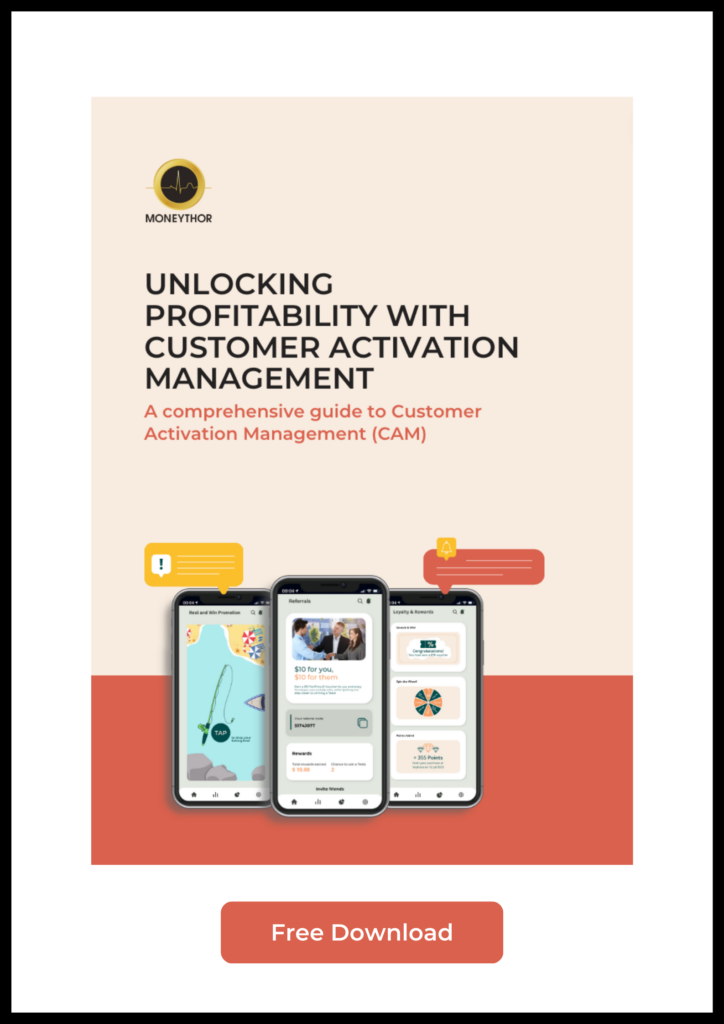The current state of play
In today’s competitive banking landscape, there is an imperative for incumbent and new digital banks to grow their profitable customer base. Current methods are failing. When surveyed, only 23% of financial institutions said that their acquisition strategies were successful. Banks today struggle to effectively acquire customers and when they do, they struggle to engage them post-acquisition. 15% of newly acquired customers drop-off within the first 3 months and it takes on average 12 months for a customer to become profitable.
The current technologies and approaches available are not effective at data tracking and management, nor are they suitable for the long-term engagement of customers. What is the point of acquiring a customer who doesn’t use your product or service? Or one who ends up costing you money to acquire?
With so much data and innovative tools on the market, it is surprising that these significant challenges have not been met with a solution.
Banks need a systematic solution that can allow them to not only engage customers as they acquire them, but to activate them and ensure product adoption and usage from the start of the relationship.
That’s why Customer Activation Management needs to be an important part of banks’ growth strategy, helping them overcome the above-mentioned challenges and position them on a path towards sustainable business growth.
What is Customer Activation Management?
“Customer Activation Management focuses on the systematic and purposeful process of acquiring, engaging, educating, and motivating customers to actively and effectively use the financial institutions’ products or services. It aims to acquire and convert passive customers into actively involved and loyal ones, thereby maximising the value of each customer relationship.”
No doubt most people have come across the term “activation” in some form throughout their career. It can loosely be applied to activities that encourage product adoption and the most common definition found for activation is “the first time customers get value from your product”.
In the grand scheme of how valuable active customers are to financial institutions, this definition does not cover the real impact that effective activation can have. What’s more, the idea of the “first time” implies that activation is a one-time thing, where in reality, continuous product adoption and usage are key growth factors for financial institutions.
It begs the question: why has there not been an effective approach created to ensure that activation techniques become an integrated and crucial piece of a bank’s path towards growing their profitable customer base?
It was with this thought in mind that the concept of Customer Activation Management was born.
What are the benefits of Customer Activation Management?

Data-driven insights
Customer Activation Management enhances data-driven insights by providing a continuous stream of user interactions and behaviours, enriching the data pool for more accurate and actionable analytics.

Improved cost efficiency
Customer Activation Management optimises cost efficiency by reducing the need for costly and ineffective traditional customer acquisition, as active customers are more likely to stay, use more services, and require fewer resources for retention in the future.

Increased product adoption
Customer Activation Management drives product adoption by creating engaging experiences and personalised incentives that motivate customers to explore and use a wider range of services.

Creates profitable customers
Customer Activation Management ensures that customers fully adopt and utilise their banking products, increasing revenue opportunities and their lifetime value. By implementing CAM, banks can reduce churn, enhance loyalty, and ultimately drive sustainable profitability.
How can Customer Activation Management (CAM) help to drive profitability?
Customer Activation Management is a strategic approach that improves customer activation and can impact a bank’s bottom line by increasing product usage, reducing churn, and optimising costs. It fosters long-term profitability by nurturing and maximising the value of customer relationships from the beginning. Customer Activation Management (CAM) can significantly drive profitability for banks by:
- Increasing Product Adoption
CAM ensures that customers actively engage with and adopt a wider range of banking products and services. This leads to increased fee income, interest revenue, and cross-selling opportunities.
- Reducing Customer Churn
By proactively activating customers and providing personalised insights, CAM helps reduce customer attrition. Retaining existing customers is more cost-effective than acquiring new ones.
- Enhancing Cross-selling
CAM enables financial institutions to identify opportunities to cross-sell relevant products to active customers, thereby increasing revenue from existing customers.
- Improving Customer Loyalty
Activating customers from the start and offering personalised experiences lays the groundwork for long-term loyalty. Loyal customers are more likely to stay with the bank and use its services over the long term.
- Creating Competitive Advantage
Banks that implement CAM effectively can differentiate themselves in a crowded market, activating and retaining more customers and standing out from the competition.
6 best practices for implementing Customer Activation Management
Start early in the journey
It is not uncommon for financial institutions to focus solely on acquisition without thinking about activation. However, having the foresight around what you want your customers to do post-acquisition can be incredibly valuable and is a key part of any Customer Activation Management (CAM) approach. For CAM to yield its full effectiveness, activation must not be an afterthought; instead, it should be seamlessly integrated into the customer journey right from the start.
Activation is not a one-time thing
As previously noted, activation has traditionally been perceived as the initial instance where customers experience value from a product or service, limited to their onboarding journey. This traditional perspective is a significant factor contributing to the limited success of current activation methods. When implementing Customer Activation Management (CAM), it is crucial for banks to broaden their focus beyond the first valuable interaction. They should strive to establish and maintain regular, ongoing valuable interactions throughout the entire customer journey.
Personalise Experiences
Personalisation is a critical element in the effective delivery of customer activation strategies. In today’s highly competitive banking landscape, one size no longer fits all. Customers expect tailored experiences that resonate with their unique needs and preferences. Personalisation enables banks to activate customers on an individual level, providing relevant content, product recommendations, and incentives that drive them to actively adopt and utilise banking products. By understanding the customer’s journey and behaviour, banks can create a seamless and personalised activation process that not only captures their attention but also builds a sense of value and trust. This, in turn, fosters long-lasting customer relationships, boosts loyalty, and ultimately leads to increased profitability for the bank.
Integrate network effects
To this day, banks rely heavily on word-of-mouth (WOM) recommendations, which account for a significant 50% of customer acquisition in the banking industry. People still seek referrals and references from their network, making referrals a cornerstone of any effective acquisition strategy.
At Moneythor, we advocate for taking referrals a step further. We believe there’s substantial value to the social and network effects of ongoing interactions between banking customers. To illustrate, we’ve introduced a model where, post initial acquisition, both the referrer or Existing To Bank (ETB) and referee or New To Bank (NTB) are continually presented with additional actions to undertake beyond the onboarding phase. Upon successful completion of subsequent milestones by both parties, rewarding incentives are extended to both, fostering a culture of continuous activation and benefit-sharing.
Smart incentives
Incentives serve as a valuable tool in customer activation, but it’s not uncommon for banks to misapply them, either in timing or execution. To address this, a more effective approach involves incorporating elements of gamification and challenges. By offering smaller incentives upon the completion of each challenge or quests, banks can keep customers engaged and motivated over an extended period. This not only ensures that incentives are applied at the right moments but also spreads out the cost of these rewards, making the activation strategy more cost-effective in the long run. The result is a more sustainable and engaging approach to customer activation, aligning incentives with customer behaviour and driving long-term success for banks.
Engagement post-activation
Just as initiating activation promptly after acquisition and onboarding is crucial, it’s equally imperative to maintain engagement post-CAM implementation. The average customer’s tenure with a bank spans 17 years, signifying a considerable duration for sustained engagement. Therefore, it’s vital to establish long-term engagement strategies aimed at nurturing loyalty and ensuring customers remain actively involved throughout their extended banking journey.
Moneythor’s Customer Activation Management Platform
Moneythor has launched its Customer Activation Management platform, a set of features designed to seamlessly integrate with a bank’s core systems. Our platform enables banks to effectively acquire and activate customers simultaneously, leading to increased product adoption and usage.
The CAM platform offers a range of features including referral management, vouchers, points and giftcards, cashback, challenges, and games.
We have seen first-hand having worked with clients on their activation strategies incredible results such as:
- 85%
The rate of card activation amongst customers
- 15
The average number of transactions made by customers per month.
- 1.7 million
The number of digital coupons redeemed.
Find out more about our Customer Activation Management Platform here.
Download Customer Activation Management Guide
"*" indicates required fields


